In English, tenses are divided into 12 basic tenses based on three timelines: Present, Past, and Future. In this article, Learn English Fun Way will share with you the formulas, usage, and signs of these tenses. Let’s discover together!
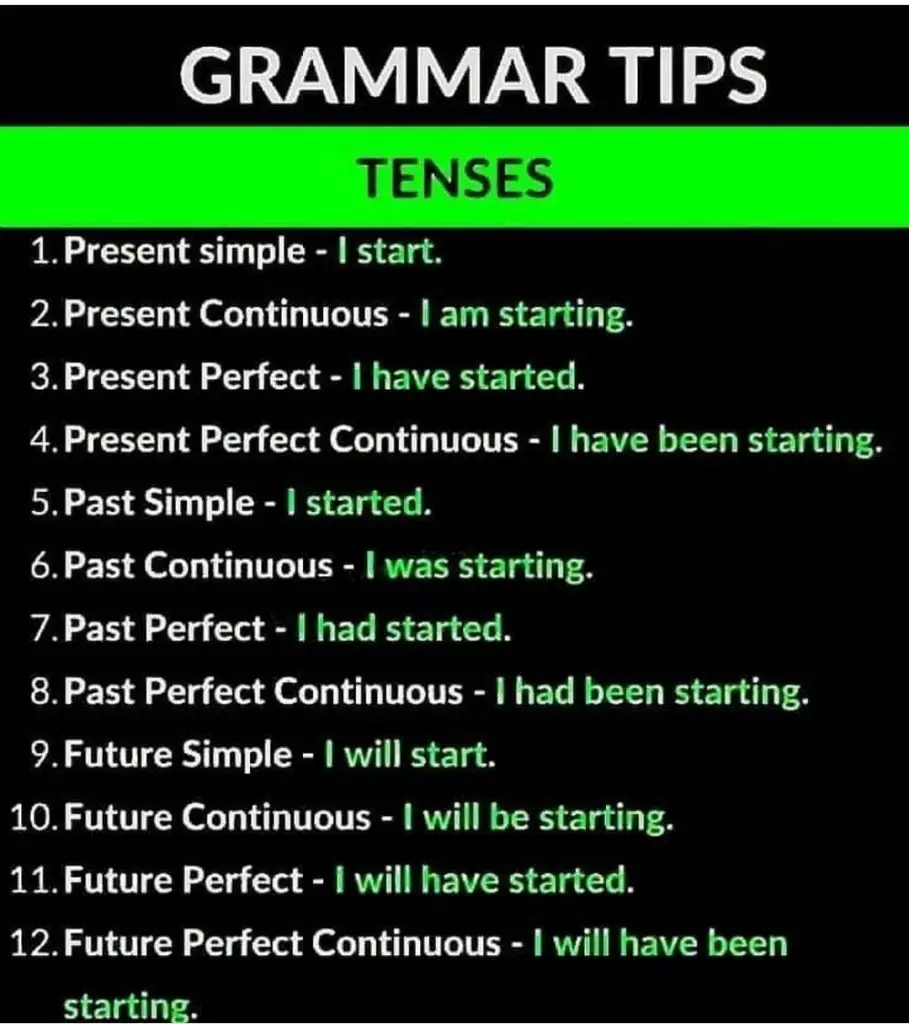
Table of Contents
1. Present simple
Form with verbs:
- Positive sentence: S + V (s / es) + O
- Negative sentence: S + do / does not + V_inf + O
- Question: Do / Does + S + V_inf + O?
Form with “To be”:
- Positive sentence: S + am/is/are + O
- Negative sentence: S + am/is/are not + O
- Question: Am/is/are + S + O?
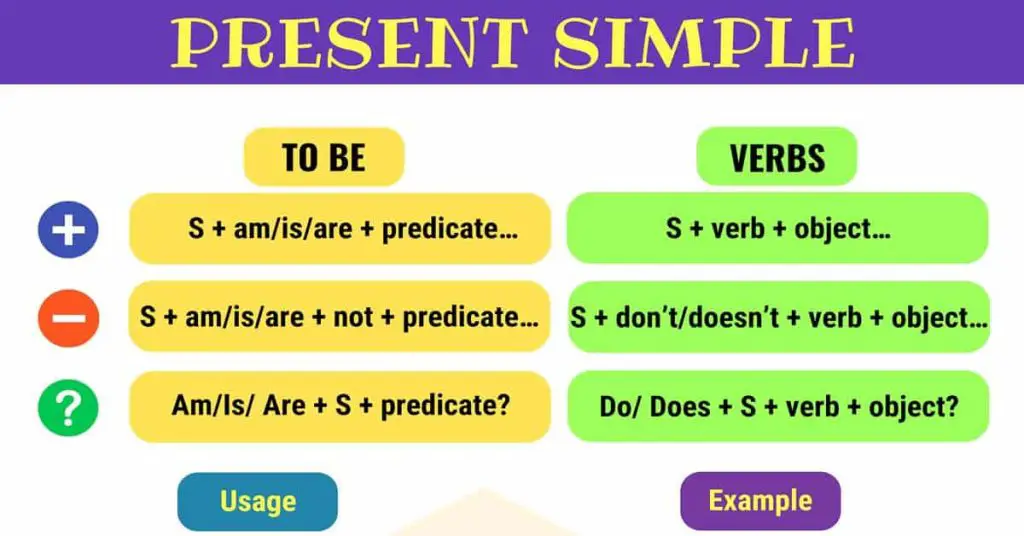
The present simple tense is used to:
- Describe a truth
- Describe a habit, hobby, or action that repeatedly happens in the present
- Describe a schedule, a program, or a timetable
Signs for present simple tense:
In the sentence there are frequency words, such as: Everyday / night / week, often, usually, always, sometimes, etc.
2. Present continuous tense
Form :
- Positive sentence: S + am/is/are + V_ing + …
- Negative sentence: S + am/is/are not + V_ing + …
- Question: Am/Is/Are + S + V_ing + …?
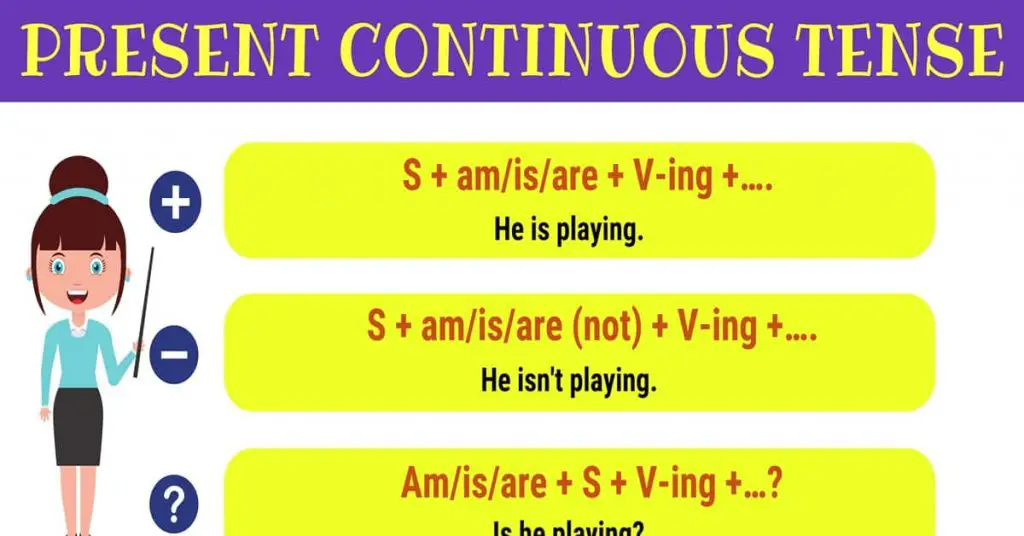
The present continuous tense is used to:
- Describe the action that is happening at the time of speaking
- Describe a planned action in the future
- Express a complaint about something, accompanied with “Always”
- Warn about something, suggest or order something
Signs for present continuous tense:
In the sentence there are adverbs of time, such as: Now, at the moment, at present, right now, etc. Or verbs at the beginning of the sentence to warn about something, suggest or order something, such as: look!, listen!, be quiet!, etc.
3. Present perfect tense
Form:
- Positive sentence: S + has/have + V3/ed + O
- Negative sentence: S + has/have not + V3/ed + O
- Question: Have/has + S + V3/ed + O?
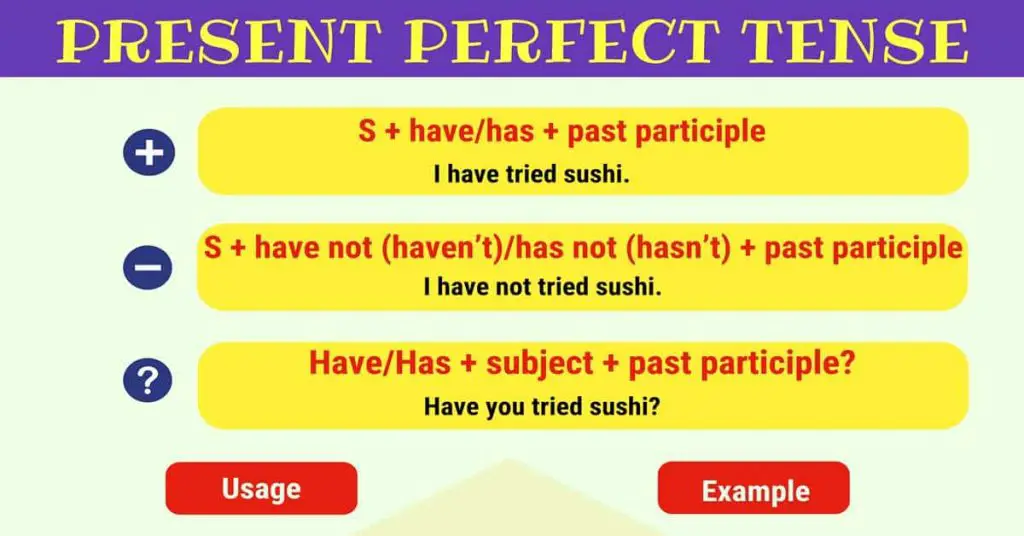
The present perfect tense is used to:
- Describe an action that started in the past and still continues in the present and future
- Describe an action that was completed in the very recent past, expressed by ‘just.’
- Describe an action that happened in the past but causes the consequence at present
- Describe experience
Signs for present simple tense:
In the sentence there are words, such as: Since, for, Already, just, ever, never, yet, recently, before, etc.
4. Present perfect continuous tense
Form:
- Positive sentence: S + has/have been + V_ing
- Negative sentence: S + has/have not been + V-ing
- Question: Have/Has + S + been + V-ing?

The present perfect continuous tense is used to:
- Emphasize an action that started in the past and still continues in the present and future; especially, the action happening in a long period of time
- Emphasize an action that happened in the past but causes the consequence at present
Signs for present continuous tense:
In the sentence there are words, such as: All day/week, since, for, for a long time, recently, lately, up until now, etc.
5. Past simple tense
Form with verbs:
- Positive sentence: S + V2/ed + O
- Negative sentence: S + did not + V_inf + O
- Question: Did + S + V_inf + O ?
Form with “To be”:
- Positive sentence: S + was/were + O
- Negative sentence: S + were/was not + O
- Question: Was/were + S + O?
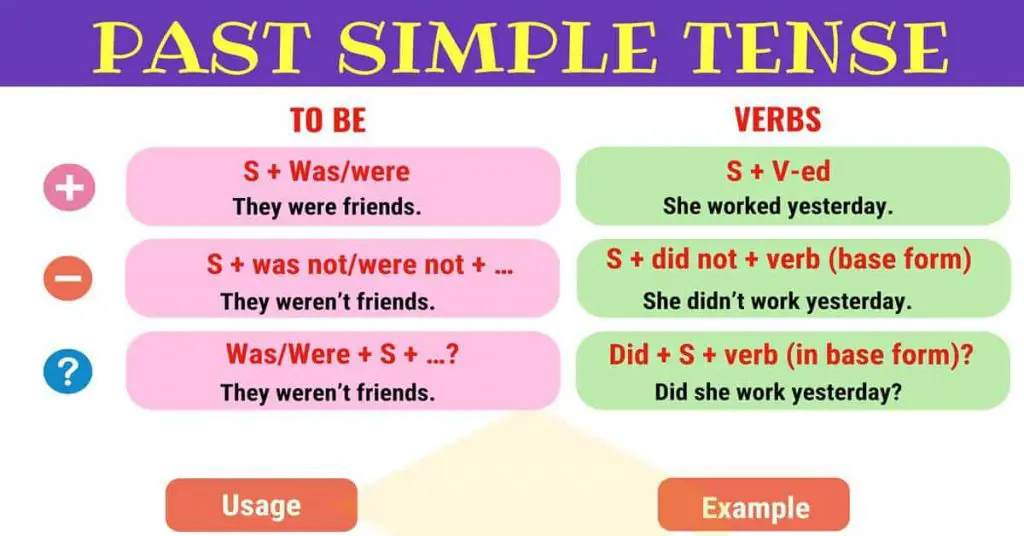
The past simple tense is used to:
- Describe an action that happened and ended at a time in the past
- Describe actions that happened consecutively in the past
- Describe a short action happened when another long action was taking place at a time in the past
Signs for past simple tense:
In the sentence there are words, such as, such as: Yesterday, last night/ last week/ last month/year, ago, etc.
There are three different ways to pronounce the ‘ed’ ending of regular verbs in the simple past tense: / Id / , / t / or / d /
- Verbs ending in voiceless sounds [p, k, θ, f, s, ʃ, tʃ] cause the “-ed” ending to be pronounced as the voiceless [t] (with no vocal chord vibration).
- Verbs ending in the voiced sounds [b, g, ð, v, z, ʒ, dʒ, m, n, ŋ, r, l] cause the “-ed” ending to be pronounced as a voiced [d].
- Verbs ending in the sounds [t] or [d] will cause the “-ed” ending of a verb to be pronounced as the syllable [əd] or [ɪd].
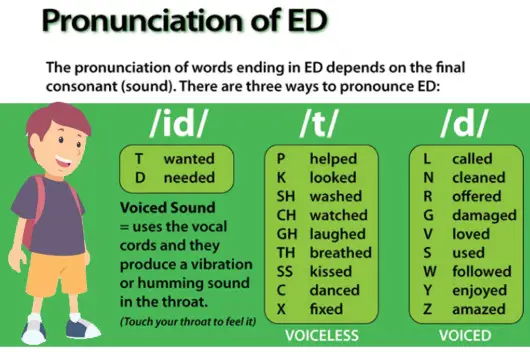
6. Past continuous tense
Form:
- Positive sentence: S + were/ was + V_ing + O
- Negative sentence: S + were/was+ not + V_ing + O
- Question: Were/was+S+ V_ing + O?

The past continuous tense is used to:
- Describe an action that was happening at a time in the past
- Describe an action was happening in the past then interrupted by another short action
- Describe actions that were happening together at the same time in the past
Signs for past continuous tense:
There are adverbs of past time to mention a definite time in the sentence, such as: At/At this time + adverbs of past time (yesterday, last week, etc.); a specific time in the past (at 7 o’clock yesterday.)
7. Past perfect tense
Form:
- Positive sentence: S + had + V3/ed + O
- Negative sentence: S + had + not + V3/ed + O
- Question: Had + S + V3/ed + O?

The past perfect tense is used to:
- Describe an action that was completed before some point in the past
- Describe an action that was completed before another action in the past. The action that happened first uses the past perfect tense, the action that happened later uses the past simple tense
Signs for past perfect tense:
In the sentence there are words, such as: By the time, prior to that time, before, after, as soon as, until then, etc.
8. Past perfect continuous tense
Form:
- Positive sentence: S + had been + V_ing + O
- Negative sentence: S + had + not + been + V_ing + O
- Question: Had + S + been + V_ing + O?
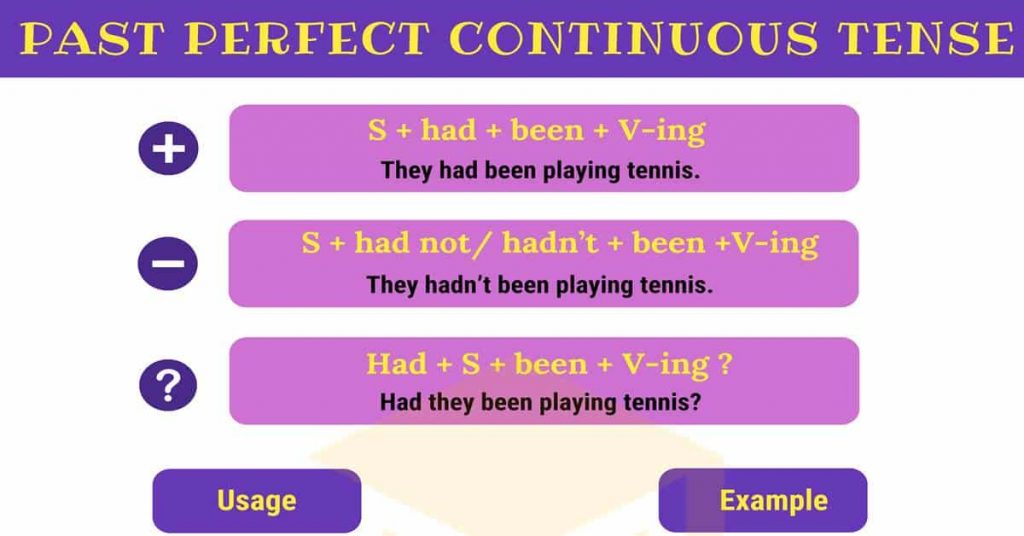
The past perfect continuous tense is used to:
- Describe an action that happened continuously before some point in the past
- Describe an action that happened continuously before another action in the past
Signs for past perfect tense:
In the sentence there are words, such as: Until then, by the time, prior to that time, before, after, etc.
9. Simple future tense
Form:
- Positive sentence: S + shall/will + V(infinitive) + O
- Negative sentence: S + shall/will + not + V(infinitive) + O
- Question: Shall/will+S + V(infinitive) + O?
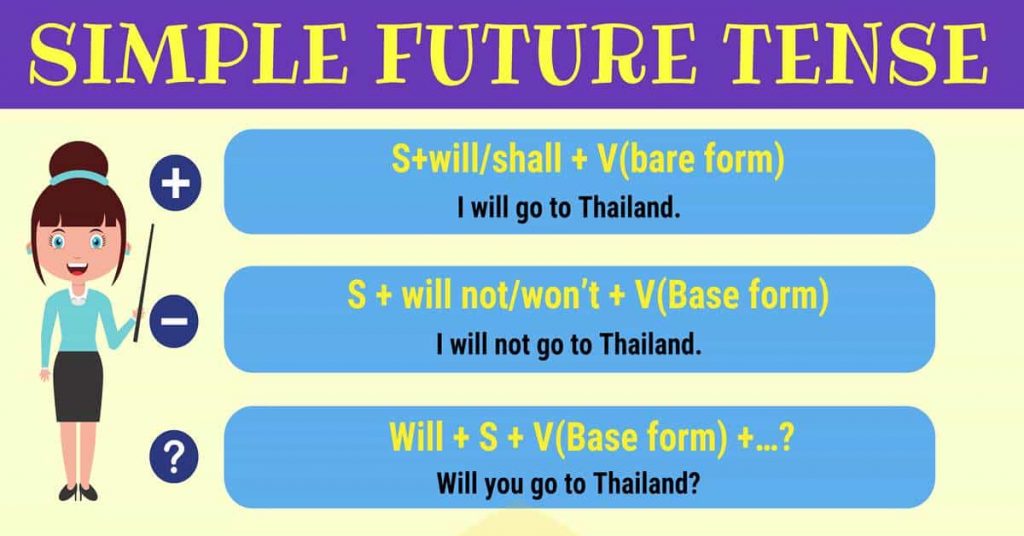
The simple future tense is used to:
- Describe a baseless prediction
- Describe a decision made spontaneously at the time of speaking
- Describe suggestions, promises, offers, threats
Signs for simple future tense:
In the sentence there are words, such as: tomorrow, next day/week/month/year, in 2025, etc.
10. Future continuous tense
Form:
- Positive sentence: S + will/shall + be + V-ing
- Negative sentence: S + will/shall + not + be + V-ing
- Question: Will/shall + S + be + V-ing?

The future continuous tense is used to:
- Describe an action happening at a specific time in the future
- Describe an action happening then being interrupted by another short action in the future
Signs for simple future tense:
In the sentence there are words, such as: next time/year/week, in the future, and soon, etc.
11. Future perfect tense
Form:
- Positive sentence: S + shall/will + have + V3/ed
- Negative sentence: S + shall/will not + have + V3/ed
- Question: Shall/Will+ S + have + V3/ed?
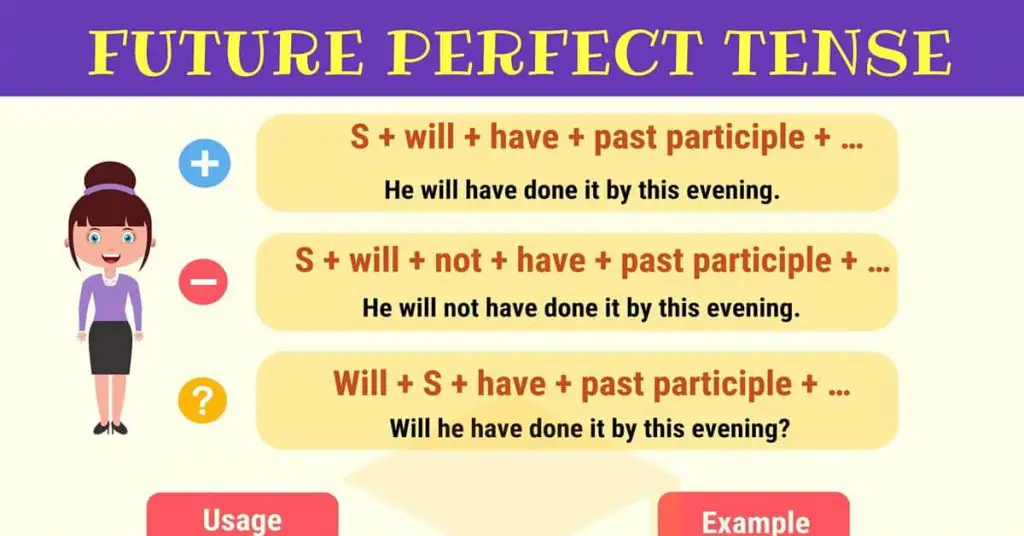
The future perfect tense is used to:
- Describe an action that will happen before a specific time in the future
- Describe an action that will happen before another action in the future
Signs for future perfect tense:
In the sentence there are words, such as: by/by the time/by the end of + adverbs of future time (tomorrow, next week, next month, etc.)
12. Future perfect continuous tense
Form:
- Positive sentence: S + shall/will + have been + V-ing + O
- Negative sentence: S + shall/will not+ have + been + V-ing
- Question: Shall/Will + S+ have been + V-ing + O?
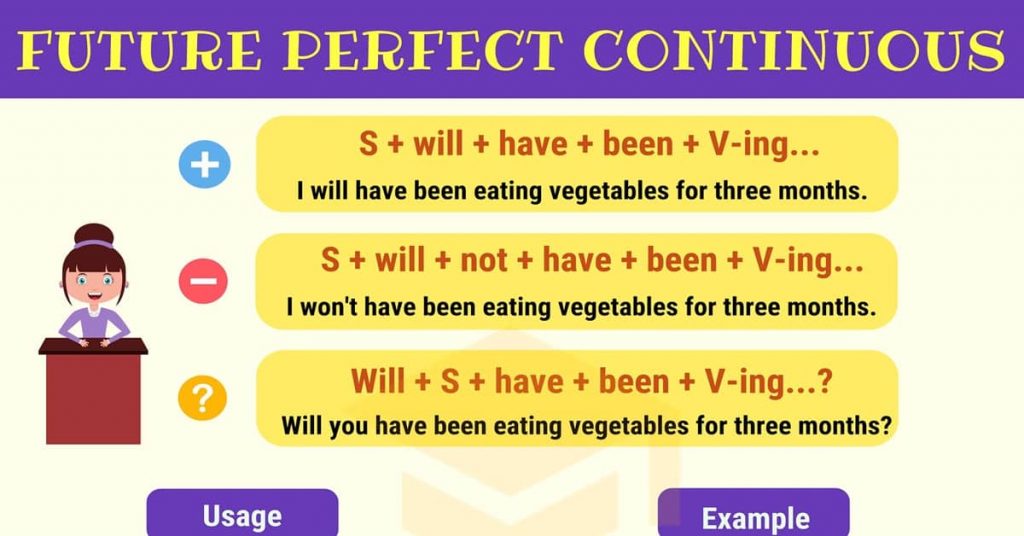
The future perfect continuous tense is used to:
- Describe an action that started in the past and continues to a specific time in the future
Signs for future perfect continuous tense:
In the sentence there are words, such as: for+ (a period of time) + by/by the time/by the end of + adverbs of future time (tomorrow, next week, next month, etc.)





Hi could you please give us some exercise in the tenses and can we send you our pronunciation and check it